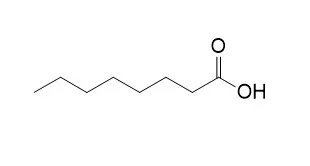| In vitro: |
| Plant Growth Regulation, 1996, 19(3):197-201. | | The effect of ethylene, octanoic acid and a plant-derived smoke extract on the germination of light-sensitive lettuce seeds.[Reference: WebLink] | The effects of an aqueous plant-derived smoke extract, Octanoic acid and ethylene on germination of light-sensitive Grand Rapids lettuce seeds were investigated.
METHODS AND RESULTS:
The smoke extract brought about a concentration dependent increase in germination and a complete inhibition of germination at high concentrations. Octanoic acid could not induce germination. Ethylene at concentrations over 5 L L–1 increased lettuce seed germination, but not to the same degree as smoke. Aqueous smoke in combination with ethylene showed a synergistic effect on germination at suboptimal smoke concentrations. At high smoke concentrations the effect of ethylene was almost completely inhibited. Octanoic acid in combination with ethylene brought about a higher level of germination than with ethylene alone, but only at the highest concentration of Octanoic acid tested (1 mM). Standardized hexane and dichloromethane-partitioned smoke extracts and Octanoic acid were subjected to TLC separation. The R f -fractions in the smoke lanes showing activity in the lettuce seed bioassay did not correspond to the R f -value of Octanoic acid. As aqueous smoke can withstand autoclaving and can be separated by TLC and HPLC without loosing activity it is unlikely that the activity of aqueous smoke is linked to ethylene.
CONCLUSIONS:
It thus appears that the active compound in smoke is neither Octanoic acid nor ethylene. | | Pesticide Biochemistry and Physiology, 1999, 65(2):90-101. | | The Relation between Structures and Toxicity of Oxygenated Aliphatic Compounds Homologous to the Insecticide Octanoic Acid and the Chemotaxis of Two Species of Drosophila.[Reference: WebLink] | Octanoic acid is the main toxic compound for Drosophila melanogaster of the fruit of Morinda citrifolia, the host plant of Drosophila sechellia. It is known that Octanoic acid is toxic for many insect species.
METHODS AND RESULTS:
The possible relation between structure and toxic activity was compared in both species. Among fatty acids with 4 to 10 carbons, a stronger toxicity of the 8-carbon chain length was observed for D. melanogaster flies. Aldehydes and ethylic esters are much less toxic than the corresponding acids. Alcohols with similar chain lengths are also highly toxic but with similar LD50 values for both species. The structure-activity studies together with species differences suggest two different toxicity mechanisms. One of these is linked to the role of Octanoic acid, for which the D. melanogaster strain Indifferent, mutant for its atypical nonrepulsion by nonanol, shows resistance comparable to that of D. sechellia.
CONCLUSIONS:
Two other behaviors were shown to be modulated by Octanoic acid and in a species-different way: oviposition and chemotaxis. The oviposition of fertilized D. melanogaster females is inhibited, while that of D. sechellia is stimulated and in a quantitatively similar way. Hexanoic acid induces a similar, strong, stimulating effect on the egg laying of D. sechellia but only weak inhibition in D. melanogaster. Both acids also attract D. sechellia and repel D. melanogaster females. Behavioral data are discussed together with genetic information. |
|






 Cell. 2018 Jan 11;172(1-2):249-261.e12. doi: 10.1016/j.cell.2017.12.019.IF=36.216(2019)
Cell. 2018 Jan 11;172(1-2):249-261.e12. doi: 10.1016/j.cell.2017.12.019.IF=36.216(2019) Cell Metab. 2020 Mar 3;31(3):534-548.e5. doi: 10.1016/j.cmet.2020.01.002.IF=22.415(2019)
Cell Metab. 2020 Mar 3;31(3):534-548.e5. doi: 10.1016/j.cmet.2020.01.002.IF=22.415(2019) Mol Cell. 2017 Nov 16;68(4):673-685.e6. doi: 10.1016/j.molcel.2017.10.022.IF=14.548(2019)
Mol Cell. 2017 Nov 16;68(4):673-685.e6. doi: 10.1016/j.molcel.2017.10.022.IF=14.548(2019)